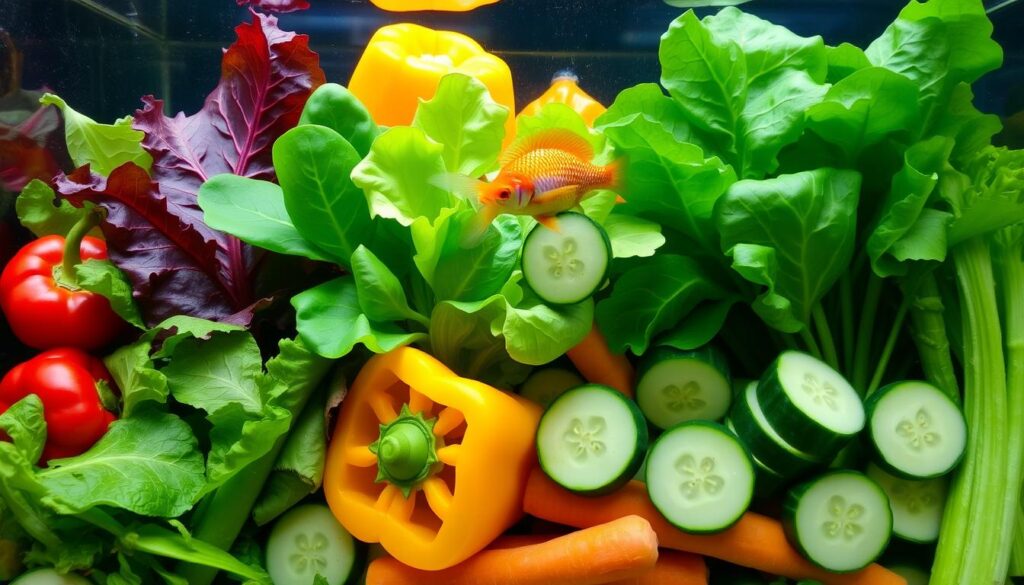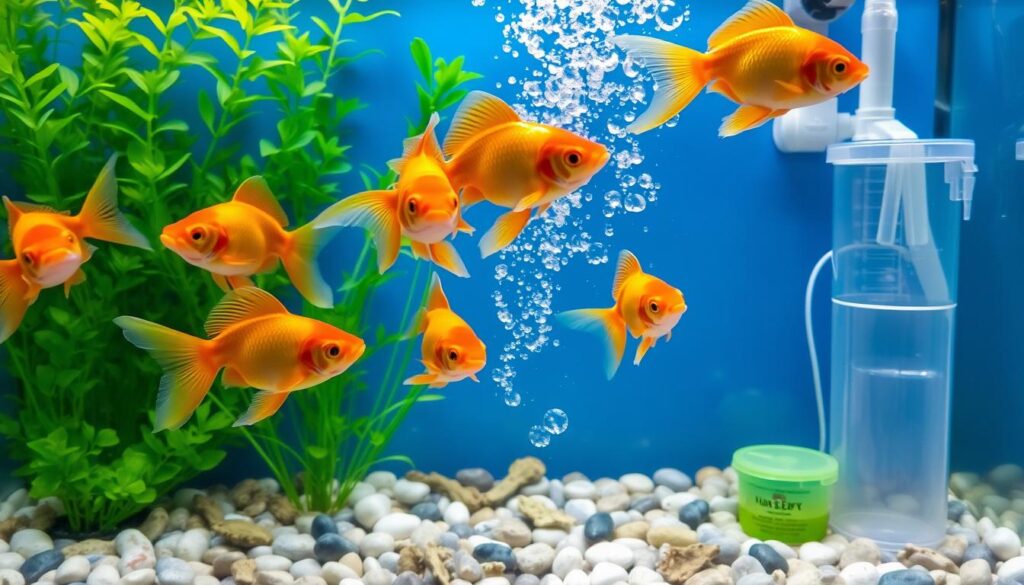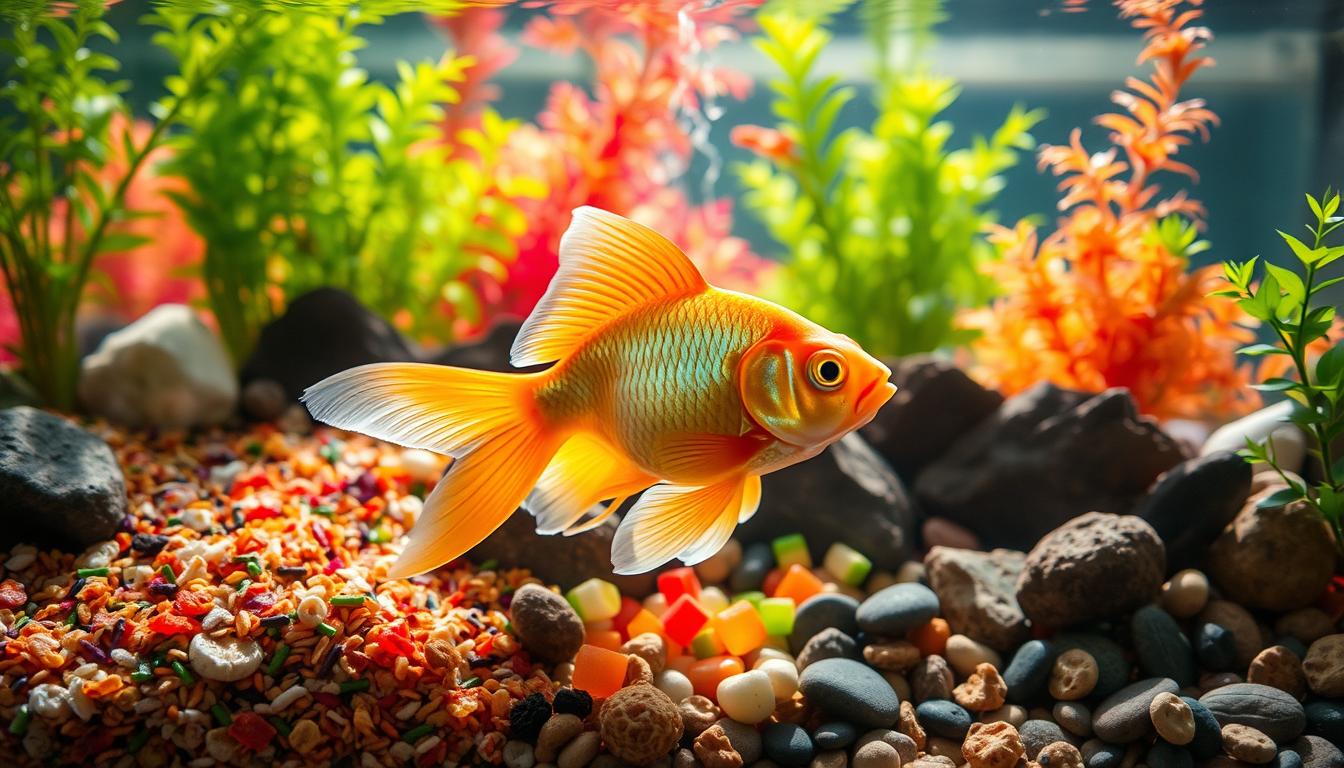Every year, over 480 million goldfish are sold, making them a favorite pet. To keep them healthy and happy for 10-15 years, knowing what they eat is key. Goldfish eat both plants and animals in the wild. It’s important to feed them right to keep their water clean and help them grow.
This guide will cover everything you need to know about feeding your goldfish. We’ll look at their natural diet and the best foods to give them.
Table of Contents
Understanding Goldfish Dietary Needs
Goldfish are fascinating creatures with unique dietary needs. In the wild, they eat a variety of plants, insects, small crustaceans, and sometimes small fish. Their varied diet shows how adaptable they are and how important a balanced diet is for them.
Natural Feeding Habits
Goldfish are like continuous grazers, similar to horses and cattle. They have long intestines that help them get nutrients from different plants, like algae and aquatic plants. This ability makes them popular aquarium fish.
Nutritional Requirements
Goldfish need a diet with about 29% protein to stay healthy and grow well. They have special features like a bilobed swim bladder and no true stomach. This affects what they need to eat. Commercial fish foods often use fish meal, which might not fit their omnivorous diet.
Impact of Water Temperature on Digestion
The water temperature affects goldfish’s digestion and metabolism. In cooler water, they digest food slower. Warmer water speeds up digestion. Keeping the water between 20-24°C (68-75°F) helps prevent overfeeding and digestive problems.
What Can Goldfish Eat: Essential Food Types
Goldfish are omnivores, which means they eat both plants and proteins. It’s key to give them a diet that’s full and varied. This diet should match what they naturally eat.
Start with commercial goldfish food like flakes and pellets. These foods are packed with vitamins, minerals, and proteins. Add fresh, plant-based foods like what can goldfish eat scalded peas, cucumber slices, and leafy greens. These help with digestion and keep them healthy.
Goldfish also need protein-rich foods like freeze-dried or frozen brine shrimp, blood worms, or tubifex worms. These should be treats to add variety and nutrients to their diet.
| Food Type | Description | Benefits |
|---|---|---|
| Flakes and Pellets | Commercially prepared goldfish food | Provides a balanced source of nutrients, vitamins, and minerals |
| Vegetables | Scalded peas, cucumber slices, leafy greens | Supports digestion and overall health |
| Protein-rich Supplements | Freeze-dried or frozen brine shrimp, blood worms, tubifex worms | Adds variety and natural nutrients to the diet |
Make sure to mix floating and sinking foods. This helps your goldfish eat naturally and prevents swim bladder problems. A balanced goldfish food types diet will help your goldfish live a long, healthy life.
Commercial Goldfish Food Options
Feeding your goldfish can be easy with commercial food. These foods are made just for goldfish, giving them the nutrients they need. You can choose from goldfish flakes, pellets, and freeze-dried fish food to keep them healthy.
Flakes vs. Pellets
Goldfish flakes are easy to feed and convenient. But, they can break down fast, which might harm the water quality. Goldfish pellets, on the other hand, are more stable. They help prevent swim bladder problems by stopping air gulping.
Freeze-Dried Foods
Adding freeze-dried fish food to your goldfish’s diet is a great idea. Foods like freeze-dried bloodworms and brine shrimp are tasty and nutritious. Your goldfish will love them.
Sinking vs. Floating Foods
Choosing the right food depends on your goldfish type. Fancy goldfish do well with sinking pellets to avoid swim bladder issues. Standard goldfish can eat both sinking and floating foods, making their tank more interesting.
Switching between different foods keeps your goldfish diet interesting and balanced. It meets their natural feeding habits and keeps them healthy.
Fresh and Natural Food Supplements
Boost your goldfish’s diet with fresh and natural food supplements. These options are packed with vitamins, minerals, and fiber. They help keep your fish healthy and happy.
Leafy greens like blanched spinach and lettuce are great choices. They’re low in fat and full of good nutrients. Try slicing zucchini into thin pieces or cubes for a fresh addition to their meals.
- Boiled peas without skin are full of fiber. This helps with digestion.
- Live or frozen foods like daphnia and brine shrimp give a natural foraging experience. They also provide important vitamins and minerals.
Start with small amounts of new foods to avoid digestive problems. Always remove any uneaten food quickly to keep the water clean.
| Vegetable | Nutritional Benefits |
|---|---|
| Spinach | High in vitamins A, C, and K, as well as iron and calcium. |
| Lettuce | Low in calories and rich in vitamins A, K, and C. |
| Zucchini | Provides fiber, vitamins B6 and C, and antioxidants. |
| Peas | Packed with fiber, protein, and essential vitamins and minerals. |
Adding these fresh and natural foods to your goldfish’s diet ensures they get a balanced meal. This supports their health and energy.

Proper Feeding Schedule and Portions
Keeping the right feeding schedule and portions is key for your goldfish’s health. Adult goldfish should eat once or twice a day. Each meal should last 2-3 minutes, so they don’t overeat.
Daily Feeding Guidelines
The amount of food depends on the water temperature. In cooler water, feed them every other day. When it’s warmer, you might need to feed them twice a day. This is because they eat more when it’s hot.
Seasonal Adjustments
Change their feeding schedule with the seasons. In cooler months, feed them every other day. In warmer months, feed them twice a day to meet their energy needs.
Signs of Overfeeding
Watch for signs of overfeeding like leftover food or cloudy water. It can harm your goldfish’s health. Use a feeding ring to keep food in place and make cleaning easier.
A balanced diet and proper feeding schedule are vital for your goldfish’s health. By following these tips, you’ll help your goldfish stay healthy and happy.
Foods to Avoid for Goldfish Health
Goldfish are tough, but they still need careful food choices. Some human foods and commercial products can harm them. To keep your goldfish healthy, avoid these foods:
- Bread – Bread can make goldfish bloat and upset their stomachs.
- Mammalian Meats and Fats – Goldfish can’t digest these, leading to swim bladder issues.
- Protein-Rich Foods – Too much protein from flakes or pellets can harm their swim bladders.
- Carbohydrate-Heavy Foods – These foods offer little nutrition and can upset their stomachs.
Always check if a new food is safe and good for your goldfish. A balanced diet is key to their health and happiness.
| Food Item | Why to Avoid |
|---|---|
| Bread | Can cause bloating and digestive issues |
| Mammalian Meats and Fats | Goldfish cannot digest these properly, leading to swim bladder problems |
| Protein-Rich Foods | Overfeeding can contribute to swim bladder disorders |
| Carbohydrate-Heavy Foods | Provide little nutritional value and may cause digestive distress |
Special Dietary Considerations for Fancy Goldfish
Fancy goldfish, like orandas or bubble eyes, need special food because of their body shapes. Their bodies are more likely to have swim bladder problems if they eat the wrong food. So, it’s important to think about their fancy goldfish diet and feeding oranda goldfish carefully.
Body Shape and Feeding Needs
Fancy goldfish have bodies that make it hard for them to eat floating food. They often gulp air trying to get to the surface, which can cause swim bladder issues. To avoid this, feed them sinking pellets that go to the bottom. This way, they can eat without gulping air.
Specific Food Requirements
- Give them smaller, more frequent meals to help with digestion and avoid overfeeding.
- Some fancy varieties, like orandas, might have vision problems. Make sure their food is easy to see and reach.
- Using gel-based foods is a good idea because they’re easier for these fish to digest.
By carefully watching their fancy goldfish diet and feeding oranda goldfish, you can keep them healthy and happy.
The Role of Diet in Water Quality
Keeping your goldfish’s water quality right is key to their health. What they eat greatly affects their tank’s water. Too much food can cause waste, upsetting the tank’s balance and harming your fish.
Food and waste left uneaten can raise ammonia levels. This can be toxic if not managed. To avoid this, watch how much you feed your fish. Also, use a gravel vacuum during water changes to clean up the bottom of the tank.
A good filter is also vital for clean water. Make sure your tank has a strong filter, like a canister or power filter. Testing the water often for ammonia, nitrite, and nitrate levels helps spot problems early.
- Give your goldfish a balanced diet to cut down on waste and keep the water quality good.
- Do regular water changes and use a gravel vacuum to clean the tank.
- Keep a working filtration system to keep the water clean and healthy.
- Test the water often to make sure ammonia, nitrite, and nitrate levels are safe.
By controlling your goldfish’s diet and keeping up with tank care, you can create a great home for them. Enjoy a beautiful, well-kept aquarium.

Feeding for Optimal Growth and Health
Feeding your goldfish right is key for their growth and health. Give them a mix of proteins, vitamins, and minerals. This diet supports their development and keeps them well.
Young goldfish grow fast and need to eat often. As they get older, adjust their food and how often you feed them. Watching how they act and look helps you make sure they’re eating well.
If your goldfish seems sick or is eating wrong, see a fish vet. They can give advice to help your goldfish stay healthy.
Feeding Guidelines for Optimal Growth and Health
- Feed goldfish in a pond 2-3 times a day during warm weather and once a day or every other day in cooler weather.
- High-quality commercial goldfish foods should contain around 30-35% protein for proper development.
- Feed goldfish as much as they can consume within 2-3 minutes to avoid overfeeding and water quality issues.
- Goldfish metabolism slows down below water temperatures of 50°F (10°C), and feeding should be reduced or stopped to prevent health issues.
- Observe goldfish behavior during feeding to gauge appetite and adjust feeding amounts accordingly.
Seasonal Feeding Adjustments
In warm months, goldfish are more active and need to eat 2-3 times a day. They should eat what they can in 5 minutes. As the seasons change, adjust how often and how much you feed them. This ensures they get the right food for their health and growth.
| Season | Feeding Frequency | Feeding Amount |
|---|---|---|
| Warm Weather | 2-3 times per day | What they can consume in 5 minutes |
| Cooler Weather | Once a day or every other day | Reduced to prevent overfeeding |
By following these guidelines and watching your goldfish, you can make sure they’re eating right. This helps them thrive in your care.
Conclusion
Knowing the right goldfish care tips and following a good aquarium fish feeding guide is key. Give your goldfish a mix of commercial foods, fresh veggies, and treats now and then. Keep an eye on the water quality and adjust how much you feed based on the temperature and your fish’s age. This way, goldfish can live happily in your home aquarium for many years.
Goldfish are a favorite pet, especially for kids, because they’re easy to care for. They don’t need daily walks, grooming, or training. But, they do need regular feeding and some upkeep to stay healthy.
By keeping their home clean and well-filtered, feeding them right, and giving them enough space, you can keep your goldfish healthy. Caring for a pet also teaches kids about responsibility and empathy. Watching their goldfish swim can be very comforting for them.

